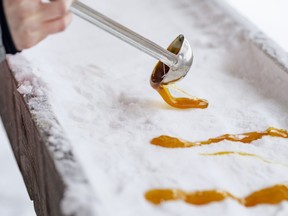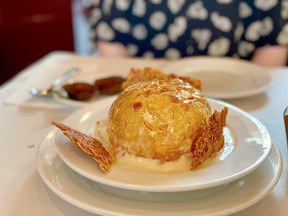

Reviews and recommendations are unbiased and products are independently selected. Postmedia may earn an affiliate commission from purchases made through links on this page.
Article content
Delicate wisps of steam rise above an enormous cauldron hovering over a crackling wood-burning fire. Orange ribbons tied to a nearby tipi frame flutter in the wind. The air is filled with the sweet scent of sap, and floating along that breeze is a welcoming song, its rhythm set by the beat of a hide drum. It’s a moment to savour before tapping into one of the most quintessentially Canadian experiences. Yes, folks, it’s maple time.
Advertisement 2
Article content

Article content
I’m at La Maison des Peuples Autochtones, a multi-nation museum on the traditional territory of the Abenaki in Quebec’s Monteregie region. Set on an ancient maple bush, this National Historic Site unveils the Indigenous origins of maple culture. It’s a revelation that goes beyond the familiar sight of massive supermarket jugs of syrup, reminding us that Indigenous Peoples have been tapping trees for thousands of years, long before the Europeans set foot in the New World.
As consistent as the frosts begin their thaw, sugar maples awaken with the promise of sap, and with it, Québec’s sweetest tradition is ushered in each spring. Canada’s cold winters and warm spring days create the ideal conditions for sap flow.
Not only are we blessed with vast quantities of sugar maples, but the leaf is immortalized on our national flag and on the ankles of far too many Gen Xers who went backpacking in the ’90s. It’s a symbol of Canadian identity and pride (tattoos notwithstanding).

Before heading to Quebec, I assumed sugar shacks were one size fits all. You know, a rustic cabin sporting a wood-burning stove, serving up pea soup, baked ham and pancakes – all doused in maple syrup. Perhaps that was the case once upon a time, but today’s sugar shacks come in many forms and, for the most part, have been refreshed for modern tastes.
Advertisement 3
Article content
My daughter and I began our maple crawl at La Maison des Peuples Autochtones, and I’m glad we did. The heritage site offers more than just a peek into the traditional methods of sap collection and syrup production – age-old practices passed down through generations of Indigenous Peoples.
After our welcome, we stroll through the maple bush, where metal cans have replaced wooden buckets affixed to trees. Deer and squirrels dot the property, moving quickly between the sun-dappled maples.
Inside, we learn traditional maple-ing methods, and gawk at the enormous wooden spatula with a small hotel in the paddle. You’d know the sap had boiled long enough if bubbles formed after blowing through the hole.
We met up with the site’s educational director, Audrey Renaud, who explained how, after taxing winters living off the remnants of preserved meat, maple was crucial to the survival of Nations.
“Maple sugar offered enough energy so they could hunt for a day. It was a bridge between winter and when they could eat from the forest with the arrival of fiddleheads in May,” she explained.
Article content
Advertisement 4
Article content
At the on-site cafe, visitors can tuck into Indigenous-inspired dishes infused with the rich flavours of maple. We opt for crustless sugar pie, still warm from the oven and a boreal herbal tea. It hits the spot and tides us over until our next maple experience hours later at restaurant Le Coureur des Bois, in the nearby town of Beloeil.
Its multi-course tasting menus subtly celebrate maple season. We begin with a pear, elderberry and cognac cocktail splashed with maple. It’s warming and, thankfully, not too sweet.
One of our first courses is potatoes boiled in maple water, served in a puddle of mayonnaise, and sprinkled with grated dried scallop, a briny contrast to the sweetened carb. There’s rabbit terrine layered with maple ham and, to finish, crepes fried in duck fat before being caressed with maple butter. We complement our meal with wines – many of them local – from their award-winning wine cellar.

While sugaring dates are weather-dependent, the season typically spans from the end of February until the end of April. Some sugar shacks, such as La Cabane du Coureur, are even open year-round. While they offer a communal dining experience echoing the traditional sugar season feast, it does so with a gourmet twist.
Advertisement 5
Article content
When we arrive at 10 a.m. for brunch, the cabane is already packed with families. Cher playing from the speakers is mingled with the excitable shrieks of children cresting along their maple high. We settle in at a long wooden table beside other families and tuck into a feast of epic proportions.
First comes the obligatory pea soup, though this one is topped with a succulent ham that’s been slow-roasted on the bone for 24 hours. There’s also fried chicken and Brussels sprouts dressed up with maple butter, plus ribs glazed in (of course) maple syrup.
I’m unsure where the maple was in the shrimp roll – dozens of Matane River shrimp crammed into a hot dog bun and sprinkled with trout caviar and deep-fried pork crackling. But who cares when it tastes better than any lobster roll you’ve ever scarfed down. It’s a complete meal but only the first of three courses.

With no time to waste, the second course appeared with a shiny maple trout sitting on a blanket of mussels in a decadent creamy leek sauce. There’s a stew of veal meatballs, plump sausages and thick slices of bacon with cassoulet beans and potatoes swimming in a foie gras sauce.
Advertisement 6
Article content
It was almost too much, but there was no way I wouldn’t mop up that foie gras sauce with the house-made focaccia – even though the spongy bread was already thickly spread with whipped ricotta and truffle sauce. I may or may not have slightly loosened the notch in my belt and not regretted it.
We’re about to surrender when a friendly tablemate leans over and asks if this is our first sugar shack experience. We admitted and apologized for our inexperience. He waved our protests away and explained how sugar shacks are more than just a meal; they’re used as a social hub for friends and family.
“It’s not a tourist trap,” assured local Frédéric Pichette. “It’s very deeply rooted in our culture.”
As we surrendered to thick crepes slathered with cream and maple, Fred explained how sugar shacks evolved into cultural celebrations as men returned home from lumberjack camps.
“Each spring, they’d come back with extra food from the camps and would want to share it while celebrating with their neighbours and families. It’s a tradition that’s carried on.”
Luckily, not all sugar shacks are situated in the countryside. Because it’s become such a part of the culture, urban sugar shacks have begun popping up in Quebec’s cosmopolitan centres, allowing city dwellers the opportunity to savour the sweet springtime passage.
Advertisement 7
Article content
Days later, in Montreal, we’re delighted to find one such representation in Parc Jean-Drapeau. With gingham table runners topped with mason jars filled with pickled beets and gravy boats brimming with deeply golden maple syrup, Ste-Hélène Bistro-Terrasse transforms from restaurant to sugar shack during the season.
During our urban cabane au sucre experience, we indulged in another multi-course meal, starting with savoury pea soup, which was so thick it held up our spoons vertically. It’s followed by coleslaw, sausages, maple ham, beans, potatoes, corkscrew crispy pork rinds still warm from the oven, a soufflé omelette and the piece de resistance: pudding chômeur. Its gooey caramelized maple sauce is the perfect contrast to the airy vanilla cake and manages to hit just the right note of sweetness without being cloying.

Incredibly, we’re still up for more maple and head outdoors to pull maple taffy from popsicle sticks while men in plain shirts transform thick logs into works of art next to blazing fire pits.
As we discovered during our sugar shack crawl, food is often the easiest and most efficient way to seep into a different culture. Stepping into a cabane au sucre is, most certainly, a sweet immersion into Québécois life.
Advertisement 8
Article content
More than a meal, it’s a way to reconnect with loved ones. For us visitors, it’s a way to quickly make new friends. As sure as the maple sap begins to flow each spring, you know community will be gathering.
Memorable meals not to miss in Montreal
The trails and weather are often too unpredictable for outdoor adventures, so spring is an ideal season for culinary getaways. As a bonus, the absence of summer crowds makes it possible to score sought-after reservations. Here are a few classic Montreal restaurants not to miss.
A fixture in Montreal’s culinary scene since 1938, Moishes is a classy Jewish steakhouse you can easily walk to from the Old Port. Upon arrival, you’ll be given bread, whipped butter, coleslaw and the largest dill pickles you’ve ever seen.

Then it’s a big decision about which steak to order, as they typically sit around the 18 oz mark. Fortunately, there’s no shame in sharing one. Choose your sauce: chimichurri peppercorn or bordelaise before determining if you can handle your beef topped with truffle butter, shrimp, a lobster tail or pan-seared foie gras. Sides are steakhouse classics with stuffed baked potatoes, creamed spinach, fried onions, lobster mac and cheese, and bone marrow. Yes, it’s a lot, but you can take home your leftovers.
Advertisement 9
Article content
Reminiscent of the bustling cafes in Paris, L’Express exudes timeless charm with its brasserie decor in its narrow space along Rue St. Denis. As you peruse the menu, a jar of cornichons and sliced baguette served on a silver plate will be placed on your table.

This is the spot to indulge in traditional French fare from steak frites to moules marinières to roasted rabbit (yes, it tastes like chicken) and duck confit. Our server at Moishes recommended we save room for île flottante (merengue floating on a crème anglaise), and we’re so glad he did.
Restaurant de l’ITHQ is staffed by graduates of the Institut de tourism et d’hotellerie due Quebec. Meaning: Meals here are prepared by recent hotelier graduates and supported by their instructors. You won’t find a more affordable tasting menu in the city, and there are also a la carte options.
Our taste buds were treated to squid ink ravioli stuffed with snow crab after a confit of charred leeks and radish medallions splashed with seaweed vinaigrette, tasting like the essence of spring on a plate.
https://www.ithq.qc.ca/en/restaurants-and-bar/restaurant-de-lithq/
Advertisement 10
Article content
Students are professional and eager to please, which also extends to their on-site hotel. Hotel ITHQ (also staffed by recent hospitality graduates) offers thoughtfully laid-out guest rooms brimming with every amenity you could want, right down to the properly sized champagne, wine, and beer glasses in each guest room.

Breakfast is included in your room rate, and while it’s a buffet, it’s a substantial one with hot and cold items. Hovering around $200 per night and steps away from a metro station, you’d be hard-pressed to find a better-value hotel in Montreal.
Looking for more Quebec trip ideas? You may be interested in: Everything You Need to Know About Spring in Montreal and The Girlfriend’s Guide to Quebec City.
Article content